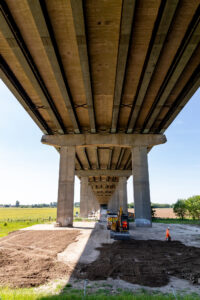Winvic Construction Ltd is in the process of replacing a series of now obsolete joints supporting a huge bridge in Yorkshire – with support from Jacobs and Amey.

The major project at Ouse Bridge, on behalf of National Highways, involves a complicated programme of design and manufacture, and engineering and construction techniques, with a host of partners and contractors with global expertise.
Winvic won the contract as part of a six-year framework, wherein it manages the design and programme schedule.
In an exclusive interview with Construction Wave, Ouse Bridge project manager at Winvic, Andrew Hart, site engineer, Jacob Lindley, and SDF north project manager, Oliver Dunderdale, talk about the unique challenges the firm faced, and the solutions required to remedy the historic overpass.
History
Ouse Bridge was designed by Scott Wilson Kirkpatrick & Partner and built by Costain between 1973 and 1976.
It carries the M62, stretches 1.35km, and spans River Ouse between Goole and Howden in Yorkshire.

The challenge
In March last year, the reinforced concrete plate girder bridge was found to have a failed joint across two of its six lanes and so they were closed.
Contraflows put in place while teams addressed the issue saw subsequent closures of the motorway, severe tailbacks at peak times, and even damage to the concrete beneath one lane, owing to the additional strain from traffic.
Then, in August 2022, it was determined that all four Maurer joints that span both carriageways should be replaced owing to water intrusion and steel corrosion – however those parts put in when the bridge was built were found to be now obsolete.
National Highways appointed Jacobs to design the new joints, and international engineering group, Trelleborg, to manufacture them in Spain. Winvic worked collaboratively at the centre of the project.
The Group will use hydro-demolition to remove existing concrete under each bearing, while Amey, National Highway’s maintenance and repair contractor, is responsible for traffic management.

“About a year ago, we were initially consulted to investigate the [Maurer] joints,” said Winvic project manager, Dunderdale. “We did some intrusive surveys to identify the problem. What we found was water intrusion and steel corrosion.
“These joints usually have a 20- to 25-year lifespan, after which contractors have to go in. The original joints were put in in 1975 and were replaced in 2001.
“From there, we went into design. We passed on all the information to Jacobs who are the principal designers, which was later developed into a working design.”
The solution
Winvic engineer, Lindley, added: “The joints come from Spain. It’s a standard type of joint made specially for the bridge and the scenario we’ve got. We employed a specialist – VSL International – to do the joint replacement works and the Spanish supplier (Trelleborg) was their chosen supplier.”
The new joints have been future proofed as part of their design, to enable easier access for ongoing maintenance and replacement purposes.
Dunderdale said the scheme will be carried out in six phases over several months, meaning traffic lane closures will occur for the workforce and public safety, but Ouse Bridge is still accessible for drivers in the meantime.
Traffic management schemes by Amey will enable switches of traffic flows, to allow works to continue.
Access challenge
Cantilevered “up and over” scaffold rigs have been set up beneath the entire span of Ouse Bridge, some reaching higher than 22 metres. However, most of the works will occur on the surface of the bridge itself.
“To replace the joints, you have to rip up the carriageway surrounding the area, which requires hydro demolition. These are replaced with open air gaps which are easier to cut out and replace if required,” said Dunderdale.
“With the hydro demolition removal of the joints, some care to the bottom of the bridge is required, such as concrete repairs and structural works to the underside.”

Dunderdale added: “The position of [River Ouse] and the water table in the ground was the first concern for us. We undertook intrusive ground investigation with specialist contractor Tony Gee, to support the scaffolding load.
“In the footprint of the scaffolding, we had to do a four-week ‘surcharge’. For every 2.2 metres we had to dig the ground out, compact it with good material which would settle the ground and to ensure no settlement happened while the scaffold was in place.
“We monitored any movement through piezometer and settlement plates and after the four weeks it was safe to put up the scaffold. We also continue to monitor it weekly.”
Partners
- National Highways
- Jacobs (design)
- Amey (traffic management)
- VSL International (design)
- Kilkern (groundworks)
- Tony Gee (surcharge)
- Layher (scaffolding)
- Premier Road Markings (construction)
- Environment Agency
Traffic contraflows will continue to be in place until March 2024 when the construction works are due to complete, with an interim lane switch for the westbound works set to occur in October/November this year.
Get industry news in 5 minutes!
A daily email that makes industry news enjoyable. It’s completely free.
